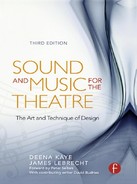Introduction to the First and Second Edition
A contemporary definition of music I’ve always liked is “organized noise.” It’s often hard to say where one element ends and the other begins, hence such new terms as “sound score” and “soundscape.” In this new ball game of hi-tech and hi-fi sound systems, the sound designer—whether working on a play with incidental music and effects on tape or on a full-blown Broadway musical—has become a critical player in the theatre world.
The sound designer has a tremendously creative role to play in any production. The old days of a couple of mono tape decks and two or three speakers are long gone. Audiences now used to rock concerts, discotheques, multitrack cinema sound, and their own stereo systems are too sophisticated to tolerate low-tech sound in the theatre. Directors’ ears have also become more acute, and directors will no longer settle for mere “library” effects pulled off the shelf and played on a public address-type system. As for composers, we should be the most demanding of all, but writing the music usually occupies most of our time, leaving little to devote to sound. Also, our technological knowledge may be very limited: sound systems can be real “monsters” these days, with wireless radio microphones for the actors, orchestra amplification, and taped effects all required. Good sound designers will know their system and its capabilities inside out, since part of their task may have been its design.
A large part of the sound designer’s creative effort is selecting effects and choosing how they will be played into the house. Take a simple cue like thunder: it can be a muddy rumble or it can be a sharp series of cracks that lift you out of your seat. Good sound designers won’t merely dub thunder off an old tape or sound effects record. They may well have their own libraries of material they’ve recorded themselves—in this case, an actual storm. At least they’ll make sure that what they’re using is carefully edited and equalized for maximum effect. The sound can then be enhanced greatly by the designer’s choice of speakers and by the use of stereo, quad, or panning effects.
Sound designers must be far more than technicians—they should understand how sounds work on the psyche, and not be overly literal. A good painter does not often achieve maximum effect with photorealism. Similarly, a precisely accurate recording of, say, street sounds may not be nearly as convincing as one that’s doctored to conform to the reality of perception. Our brains tune out a great deal of sound. It often floats in and out of our consciousness, and a certain sound like a car horn may become obsessive and dominate all others, even to the point of distortion. With this in mind, even after the sound designer has created an effect, where to begin a cue, where to end it, levels, ups and downs, and speaker assignment are all still important choices for him to make.
Innumerable decisions on innumerable cues must be made along the way to opening night. Directors can oversee, but they often won’t have the time or the expertise to get exactly what they want. In the case of straight plays, there may be no composer at all, but much existing music and many effects.
The role of sound designer has rapidly come of age, now ranking equal with those of set, costume, and lighting designers. It’s fortunate indeed that Deena Kaye and James LeBrecht have given us this excellent, informative new book on the subject.
Richard Peaslee
February 1992
